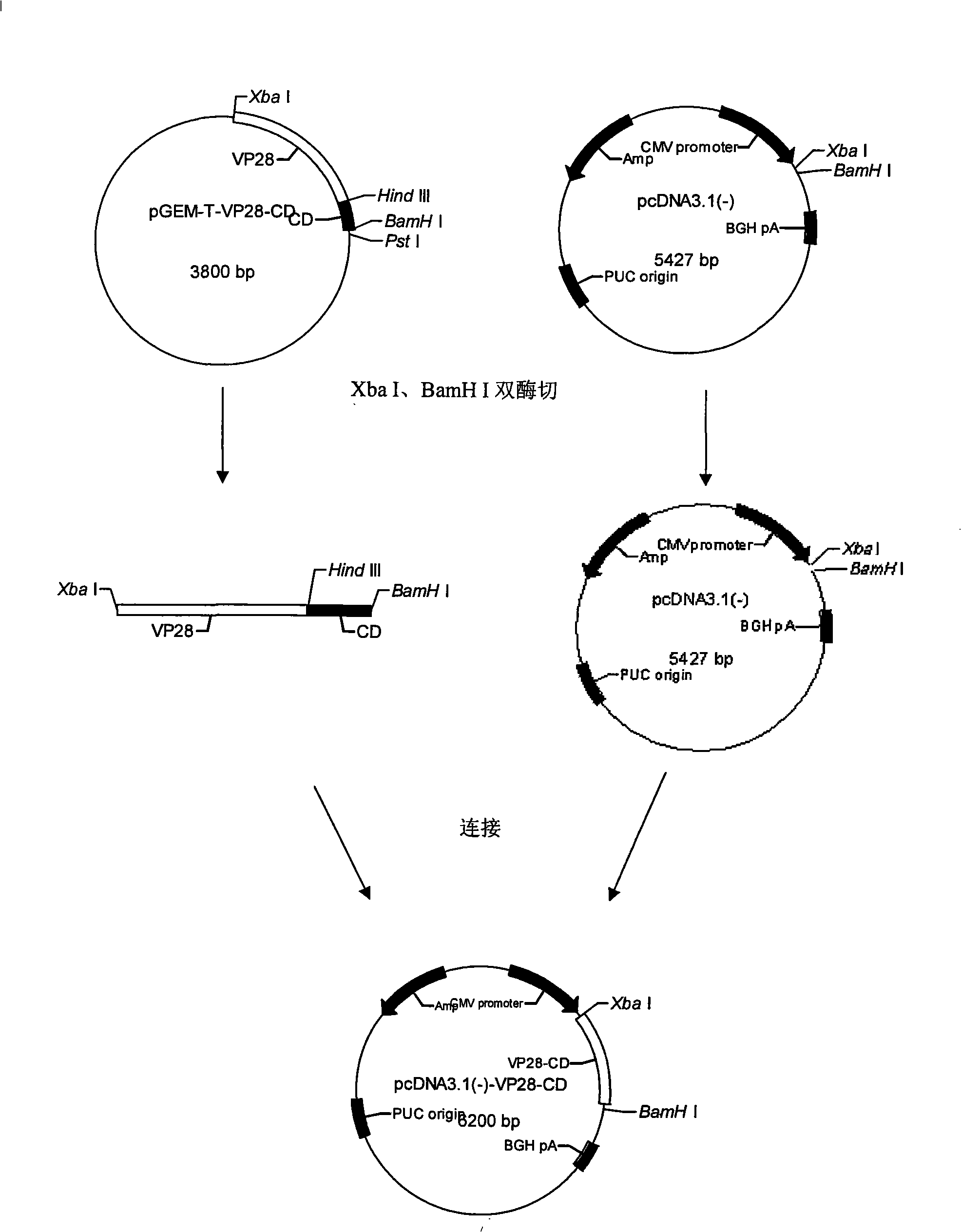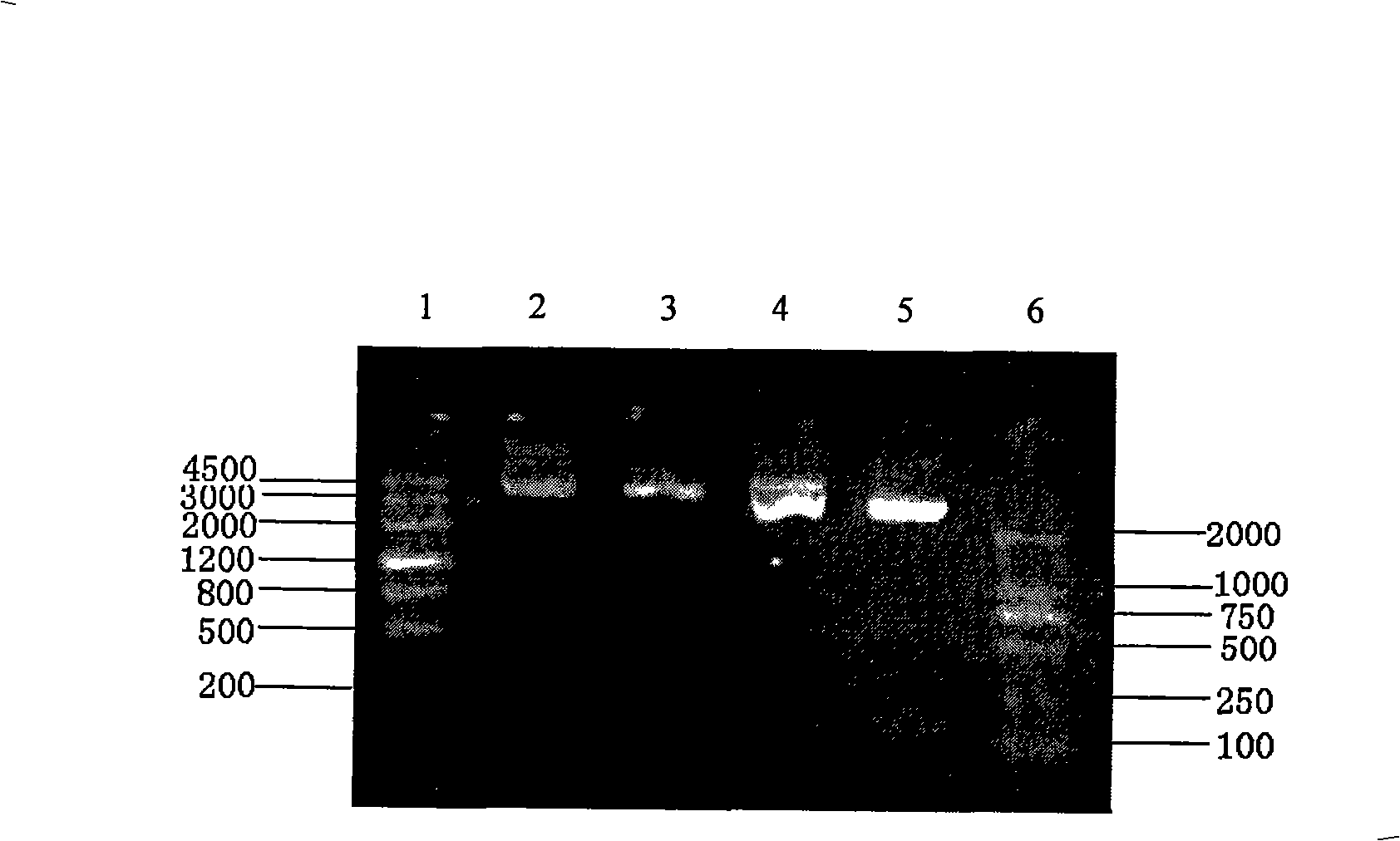Anti-shrimp white spot syndrome virus recombined bacterium typhosum strain, preparation and uses thereof
A technology of Salmonella typhi and genetically engineered strains, which is applied in the field of anti-prawn white spot syndrome virus recombinant Salmonella typhi strain and its preparation and application, and achieves the effects of simple operation process, low cost and improved immunity
- Summary
- Abstract
- Description
- Claims
- Application Information
AI Technical Summary
Problems solved by technology
Method used
Image
Examples
Embodiment 1
[0039] Example 1: Preparation of VP28 gene.
[0040] Take gills, stomach, liver and other viscera of diseased shrimp on ice, add 10 times the volume (W / V) of TN buffer solution (20mmol / L Tris-HCl; 0.4mol / L NaCl, pH7.4) to the homogenizer Homogenize in an ice bath. Centrifuge at 8000r / min for 5min, take the supernatant, add proteinase K (100μg / mL), DS buffer (50mmol / L KCl; 10mmol / L Tris-HCl, pH8.3; gelatin 0.1mg / mL; NP-40, 0.45%), boiled in boiling water at 100°C for 10-15min, immediately bathed in ice for 5min, centrifuged at 12000rpm at high speed, and took the supernatant as template DNA. Design specific primers (VP28 upstream primers, GC TCTAGA ATGGATCTTTCTTTCACTCT (the Xba I site is underlined); VP28 downstream primer, CT AAGCTT CTCGGTCTCAGTGCCAGA (the underline is the HindIII site)), amplified by PCR to obtain the sequence of the VP28 gene. PCR reaction system: 10×reaction buffer 5uL, 25mM MgCl 2 3uL (1.5mM), dNTP 1uL (0.2mM), upstream and downstream primers 1uL (...
Embodiment 2
[0041] Example 2: Preparation of CD gene.
[0042] Take 5-10 silkworms induced by Escherichia coli JM109 for 24 hours, wash them with DEPC water (0.1% diethyl pyrocarbonate aqueous solution), cut the abdominal cavity, squeeze out the fat body, and grind in liquid nitrogen In powder form, follow RNeasy R The operating instructions of the Kit were used to extract total RNA from fat body. According to the instructions of the Reverse Transcription System kit, with Oligo(dT) 20 Because of the synthesis of cDNA first strand. The reaction system is as follows: 20mM MgCl 2 12 uL, ReverseTranscription 10×Buffer 6uL, dNTP Mixture 10mM 6uL, Recombinant RNasin Rionuclease Inhibitor 2uL, CMV Reverse Transcriptase 4uL, Oligo(dT) 20 Primer 6uL, total RNA 15uL, Nuclease-free H 2 O 9uL. The reaction conditions are: 42°C for 1h, 95°C for 5min, and 4°C for 5min. The product after the reaction was used as the template of target gene cloning, and primers were designed according to the seq...
Embodiment 3
[0043] Example 3: Obtaining of VP28-CD fusion gene.
[0044]HindIII and PstI (restriction endonucleases were purchased from TAKALA company) were respectively double digested with the constructed plasmids pGEM-T-VP28 and pGEM-T-CD, and the digested products were subjected to agarose gel electrophoresis to recover pGEM- The large fragment (about 3600bp) after digestion with T-VP28 and the small fragment (about 130bp) after digestion with pGEM-T-CD.
[0045] Then, the large fragment digested by pGEM-T-VP28 and the small fragment digested by pGEM-T-CD were ligated by T4 DNA ligase (purchased from TAKALA), and the ligated product was transformed into Escherichia coli JM109 cells. Cultivate overnight at 37°C, pick a single colony on the plate for identification the next day, and name the positive clone pGEM-T-VP28-CD (the construction method is shown in the attached figure 1 shown).
[0046] The expression vector pcDNA3.1(-) (purchased from Invitrogen) and the recombinant cloning ...
PUM
 Login to View More
Login to View More Abstract
Description
Claims
Application Information
 Login to View More
Login to View More - R&D
- Intellectual Property
- Life Sciences
- Materials
- Tech Scout
- Unparalleled Data Quality
- Higher Quality Content
- 60% Fewer Hallucinations
Browse by: Latest US Patents, China's latest patents, Technical Efficacy Thesaurus, Application Domain, Technology Topic, Popular Technical Reports.
© 2025 PatSnap. All rights reserved.Legal|Privacy policy|Modern Slavery Act Transparency Statement|Sitemap|About US| Contact US: help@patsnap.com



